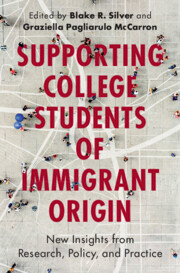Book contents
- Supporting College Students of Immigrant Origin
- Supporting College Students of Immigrant Origin
- Copyright page
- Dedication
- Contents
- Figures
- Tables
- Contributors
- Foreword
- Part I Beginnings
- Part II Experiences
- Chapter 6 Funds of Knowledge as Strategic Food and Campus Navigation at Selective, Affluent Universities
- Chapter 7 Psychosocial Stressors and Coping Strategies in Racially and Ethnically Diverse Undocumented College Students
- Chapter 8 How Colleges Can Support Working Students of Immigrant Origin
- Chapter 9 First-generation College Student Women of Immigrant Origin and Perspectives on the Role of Gender in their Experiences On- and Off-campus
- Chapter 10 Second-generation Afghan Immigrants Navigating Racial and Ethnic Identities in College
- Chapter 11 The COVID-19 Pandemic and Undocumented Hispanic/Latino/x College Men
- Part III Institutional Arrangements
- Part IV Looking Forward
- Epilogue
- Index
- References
Chapter 9 - First-generation College Student Women of Immigrant Origin and Perspectives on the Role of Gender in their Experiences On- and Off-campus
from Part II - Experiences
Published online by Cambridge University Press: 16 May 2024
- Supporting College Students of Immigrant Origin
- Supporting College Students of Immigrant Origin
- Copyright page
- Dedication
- Contents
- Figures
- Tables
- Contributors
- Foreword
- Part I Beginnings
- Part II Experiences
- Chapter 6 Funds of Knowledge as Strategic Food and Campus Navigation at Selective, Affluent Universities
- Chapter 7 Psychosocial Stressors and Coping Strategies in Racially and Ethnically Diverse Undocumented College Students
- Chapter 8 How Colleges Can Support Working Students of Immigrant Origin
- Chapter 9 First-generation College Student Women of Immigrant Origin and Perspectives on the Role of Gender in their Experiences On- and Off-campus
- Chapter 10 Second-generation Afghan Immigrants Navigating Racial and Ethnic Identities in College
- Chapter 11 The COVID-19 Pandemic and Undocumented Hispanic/Latino/x College Men
- Part III Institutional Arrangements
- Part IV Looking Forward
- Epilogue
- Index
- References
Summary
This chapter – scaffolded by an interpretive, constructivist qualitative study design supported by liminality and intersectionality theory – shares the voices of nine undergraduate FGCS women of immigrant origin enrolled at a large, 4-year, public institution in the Mid-Atlantic. Our work was guided by the following research question: “How, if at all, do first-generation college student women of immigrant origin perceive the role of gender in their experiences on- and off-campus?” Analysis of multiple interviews with and among participants as well as analysis of participant journal reflections support findings that speak to the students’ perceptions of (1) how familial expectations and country/ies of origin values related to gender roles; (2) how race, immigration status, and language further complicated students’ perceptions of immigrant-origin identities; and (3) how serving in familial roles fostered gratitude, resilience, and transformation.
Keywords
- Type
- Chapter
- Information
- Supporting College Students of Immigrant OriginNew Insights from Research, Policy, and Practice, pp. 176 - 199Publisher: Cambridge University PressPrint publication year: 2024

